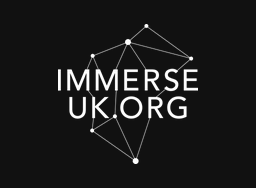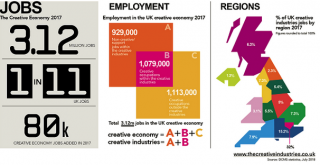Over a year ago the AHRC launched its call for a Creative Clusters programme designed to help the creative industries develop new research and development projects. In response over 40 proposals were submitted. Early this summer these were shortlisted and eventually nine proposals have been chosen to help improve the productivity and growth of the creative sector in the UK, as part of the government’s Industrial Strategy.

Interestingly, UK Universities have formed their own clusters to participate in this programme. In total, over 25 Universities are included within the final nine projects. Their partners range from the BBC and Burberry to Codebase and Duck Soup Films.
The proposals are dominated by programmes in which Universities, with the resources of over 180 staff, students, spin-offs, and Lab facilities will undertake research on behalf of:
- a range of major companies including Sony, Microsoft, Endemol, BT, and RBS;
- other industry partners ranging from the textile mill company W T Johnson and independent film company Warp Films, to VR developers nDreams, and arts promoters the Fruitmarket Gallery.
Public bodies are also part of the mix with Digital Catapult, the V&A, Creative Scotland, the Welsh Government all contributing to the match financing required to unlock the government-backed Creative Clusters’ money.

The nine proposals can be grouped into five distinct areas of creative activity.
- Fashion
- Immersive
- Infomatics
- Games and
- Creative Industries, as a whole, within a region.
These are as follows:-
Fashion
University of the Arts London;University College London;University of Cambridge; plus Loughborough and Leeds Universities and Queen Mary’s College.
Headed up by the London College of Fashion(UAL) This £7m. proposal is centered on Sustainable Products – tech, materials and design, and have two key objectives – Business Innovation and Technology Adoption.
University of Leeds; Royal College of Art and University of Huddersfield.
Focuses on creating new approach to design – ‘right first time’ – the goal is to cut development time for new fashion products from 9 to 3 months . The £6.9m proposal aims to achieve this via a combination of Digitally Connected and Sustainable Processes; Digital Communication and Data Analytics, and Creating a new apprenticeship programme.

Immersive
University of York; British Film Institute; Screen Yorkshire and independent consultant Kate o’Connor.
A £6.9m set of activities focused on skills development, in particular, story telling within an immersive environment. This work to be carried out by the Creative Media Lab partnership and involve the extensive use of research students.
Royal Holloway – University of London; Brunel University; University of Creative Arts; National Film and Television School and Pinewood Studios.
The creation of a Story Lab which combines cross company innovation; data management and next generation training are part of this £7m project. The goal is to produce 155 R&D projects, a 20% increase in funding success, plus 55 jobs and aims to reach over 1m in audiences.
The important connections for both of these proposals are the links with Audiences of the Future and the AHRC’s own VR Demonstrators.
Infomatics
Two capital cities are the focus for infomatic research projects.
Cardiff University; Cardiff Metropolitan University; University of South Wales and Town Square
Cardiff’s £6m project focuses on two area – Screen data,, especially TV, and News, a journalistic Lab. Using the existing media base in South Wales aims to build new broadcast content and platforms, while also developing new forms of news content and local news provision.
Edinburgh College of Art; University of Edinburgh; Edinburgh Napier University and Codebase
Edinburgh’s £7m budget aims to support the city’s Festivals with audience information to build wider and longer term engagement. The latter builds on the Arts Council’s digital programme and like Cardiff will involve the creation of a Lab.
Games
University of Abertay Dundee; University of St Andrews and University of Dundee
A programme with a diverse focus on games development using a University based test Lab, combined with R&D fellows in companies and the use of PhD students to create a University-based talent pipeline. The £7m proposal aims to create original IP and to stabilise the micro games company environment.
Creative Companies
Two of the Clusters spread a wide net embracing the complete range of creative companies in a region – Bristol-Bath, and Northern Ireland.
University of the West of England,;University of Bristol; University of Bath, and Bath Spa University
This £6.8m project is led by the Watershed in Bristol, which provides a firm basis for action. The overall aim is to embed R&D activity into the creative industries into the three Universities.
University of Ulster; Queen’s University Belfast; Northern Ireland Screen and RTE.
This £6.9m broad cluster will embrace many partners in Northern Ireland, including Techstart NI, Invest NI, and Belfast Harbour Commissioners. Encompassing as it does the whole range of creative industry activities, it focuses on identifying ways of improving the situation for creative companies in N.I.

AHRC Creative Clusters and the 90%.
As indicated in previous blogs freelancers and micro-companies make up over 90% of the creative industries
The Creative Industries Federation research on freelancers, which reflected, in part, the conclusions of the AHRC’s own FUSE research, provides a background to this initiative.
In this research three key things were identified as being required to improve the productivity and day-today working of these vital players in the creative industries. These were :-
- Access to finance
- Legal Advice and support
- Access to workspace
None of the proposals explicitly seeks to address these three areas of development for freelancers.
Micro-companies are listed as potential partners/supporters of the big regional proposals but only the games proposal explicitly identifies a specific problem i.e. the stabilising of the micro-games company environment, as part of its aims.

It is Too Difficult
This lack of focus on the small players within the creative industries highlights a problem which often affects national programmes. These are often aimed at bigger organisations, and dealing with small micro-companies and freelancers is seen as too difficult. However, if the industrial strategy is to work in the creative industries sector this relationship must change.
This selection of Clusters is a good starting point but it also points to other major challenges within the Creative Cluster bids strategy. It will now be up to the various Universities, and their partners, to demonstrate how they will reach out to the vast majority of the sector, and ensure the innovation, increases in productivity, and economic growth that underpin the ambitions of the industrial strategy are achieved.
